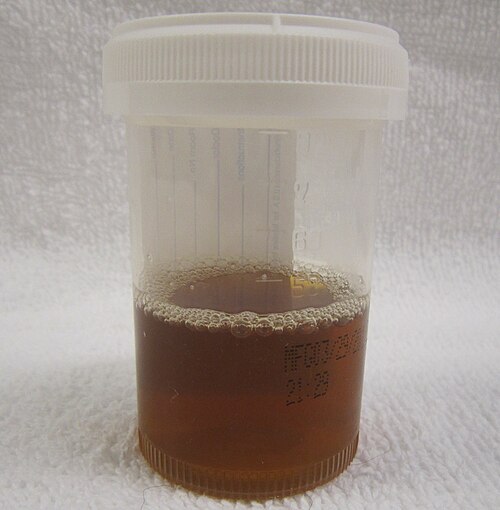Rhabdomyolysis
Rhabdomyolysis is where damaged skeletal muscles quickly break down.[3] The symptoms can be muscle pains, weakness, vomiting, and confusion. There can also be confusion and tea-colored urine.[4] Rhabdomyolysis can also injure the kidneys with myoglobin.
| Rhabdomyolysis | |
|---|---|
 | |
| Urine from a person with rhabdomyolysis showing the characteristic brown discoloration as a result of myoglobinuria | |
| Pronunciation | |
| Symptoms | Muscle pains, weakness, vomiting, confusion, tea-colored urine, irregular heartbeat |
| Complications | Kidney failure, high blood potassium, low blood calcium, disseminated intravascular coagulation, compartment syndrome |
| Causes | Crush injury, strenuous exercise, medications, drug abuse, certain infections |
| Diagnostic method | Blood test (creatine kinase), urine test strip |
| Treatment | Intravenous fluids, dialysis, hemofiltration |
| Frequency | 26,000 per year (USA) |
The most common causes of Rhabdomyolysis are crush injury, strenuous exercise, medications, or drug abuse.[5]
During rhabdomyolysis, a protein that stores oxygen in the muscles called myoglobin is released into the blood. The kidneys filter the blood and remove the myoglobin. However, the myoglobin breaks down into other chemicals which damages the kidneys which can cause severe injury or even death.
Rhabdomyolysis Media
The M-subunit of creatine kinase. In skeletal muscle, creatine kinase exists predominantly in dimers containing two M-subunits, also referred to as "CK-MM".
References
- ↑ "Rhabdomyolysis". Merriam-Webster Dictionary.
- ↑
- REDIRECT Template:Cite Dictionary.com
- From a page move: This is a redirect from a page that has been moved (renamed). This page was kept as a redirect to avoid breaking links, both internal and external, that may have been made to the old page name.
- ↑ "What Is Rhabdomyolysis?". Healthline. 2016-07-18. Retrieved 2020-09-28.
- ↑ "Rhabdomyolysis: Symptoms, Treatments". Cleveland Clinic. Retrieved 2020-09-29.
- ↑ "Rhabdomyolysis: MedlinePlus Medical Encyclopedia". medlineplus.gov. Retrieved 2020-09-29.



